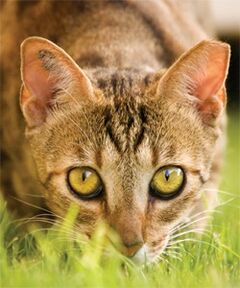TU/e allows feral cats to live on campus
TU/e’s campus is home to about twenty feral cats. Animal protection helps the university regulate this population by catching and sterilizing or castrating the animals, after which they are released on campus again. The university pays a fee for each animal that is treated.
Last week, staff and students on campus might have come across animal protection trying to trap feral cats in cages. According to estimations made by Janneke van Gorcum, volunteer for animal protection and in charge of catching the animals, approximately twenty feral cats roam the grounds of campus.
“Usually, the local authorities ask animal protection to do a job like this, but since campus is university property we’re here at the request of TU/e,” says Van Gorcum. About a year and a half ago, animal protection took action because there had been sightings of a mother cat with kittens. Van Gorcum says this was necessary because sterilization and castration is a good way to manage feral cat population. “Nobody wants a regular presence of kittens on campus, or tomcats constantly climbing on females.”
Eartip
After the cats are caught, animal protection checks their health and looks for a chip to see if they can be returned to their owners. This is followed by the neutering procedure under anesthesia and a so-called eartip. “We clip off a small piece of the ear so we’ll know which cats have been treated already,” Van Gorcum explains. “It’s not easy to approach a feral cat and this way we can tell them apart immediately.”
Fight against mice
The treated animals do not cause the university any inconvenience, Van Gorcum assures. “They do well in a familiar environment and they also help in the fight against mice on campus.”
According to Van Gorcum, the terrain of TU/e’s campus makes it difficult to catch the animals. “It’s quite a large area with lots of bushes for them to hide. Therefore, it’s important for staff and students to tell us not only where they spotted the animals, but also at what time. Was it in the morning, or at the end of the afternoon? Cats are creatures of habit and they appear in the same spots practically every day. In order to catch them, we put sardines in cages that shut close because of the cat’s weight.”
Animal protection receives a fixed fee from TU/e per animal that covers the planning, health check, treatment by the veterinarian as well as the stay at the center. Several cats have been treated during the last few months, says Van Gorcum, “but they were mostly young animals. We hope to catch an adult mom or dad soon, because then we can solve the problem at the root.”
Anyone who has spotted a cat on campus can report this on zwerfkatten@doc-eindhoven.nl. Please give a description of the animal and include information on location and time.
![[Translate to English:] Zwerfkat in een vangkooi. Foto | Dierenbescherming](/fileadmin/_processed_/1/1/csm_kat_in_kooi_c22cc6beb0.jpg)


Discussion